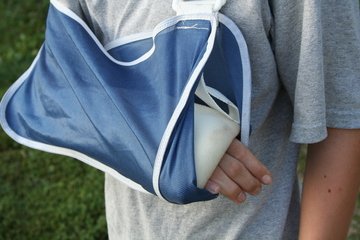Treatment at home
- The most important aspect of first aid is to stabilize the arm. Do this by using a towel as a sling. Place it under the arm and then around the neck. An alternate approach to keep the arm from moving is to position a rolled and taped newspaper along the swollen area and to tape it in place.
- Apply ice to the injured area. This can help to decrease pain and swelling. Place ice in a bag and leave it on the arm for 20-30 minutes at a time. It may be helpful to place a towel around the ice bag or in between the bag and the skin to protect the skin from getting too cold. Never put ice directly on the skin.
Medical Treatment
The most important aspect of treating fractures is to determine which fractures can be treated with outpatient care, and which require admission to the hospital.
In most instances, the broken arm will be able to be treated in the emergency department.
- Most fractures will need to have a splint or partial cast applied to stabilize the broken bones. Some breaks especially in the upper arm and shoulder may only need to be immobilized in a sling.
- In addition to splinting the broken arm, the physician will prescribe medicines for pain control and ice to decrease swelling.
- Typically, wounds that warrant admission to the hospital are these:
- Bones that have gone through the skin or have lacerations over the broken area
- Fractures that are associated with nerve damage
- Fractures that are associated with blood vessel damage
- Complicated fractures that have multiple breaks, involve the joints, or are unable to be stabilized in the emergency department or doctor’s office
A broken (fractured) arm means that one or more of the bones of the arm have cracked. This is a common injury occurring in both children and adults. In adults, fractures of the arm account for nearly half of all broken bones. In children, fractures of the forearm are second only to broken collarbones.
Broken Arm Causes
Almost all injuries to the arm that result in a broken bone are caused in two ways: falls and direct trauma.
- The typical fall that produces a fracture occurs when a person falls on an outstretched hand. The location of the fracture can be from the wrist up to the shoulder depending on the direction of the fall, the age of the person, and other factors that modify the stresses applied to the bone.
- Direct trauma can be from a direct blow from an object such as a bat, the trauma during a car accident, or any accident that causes the direct application of force to a part of the arm.
